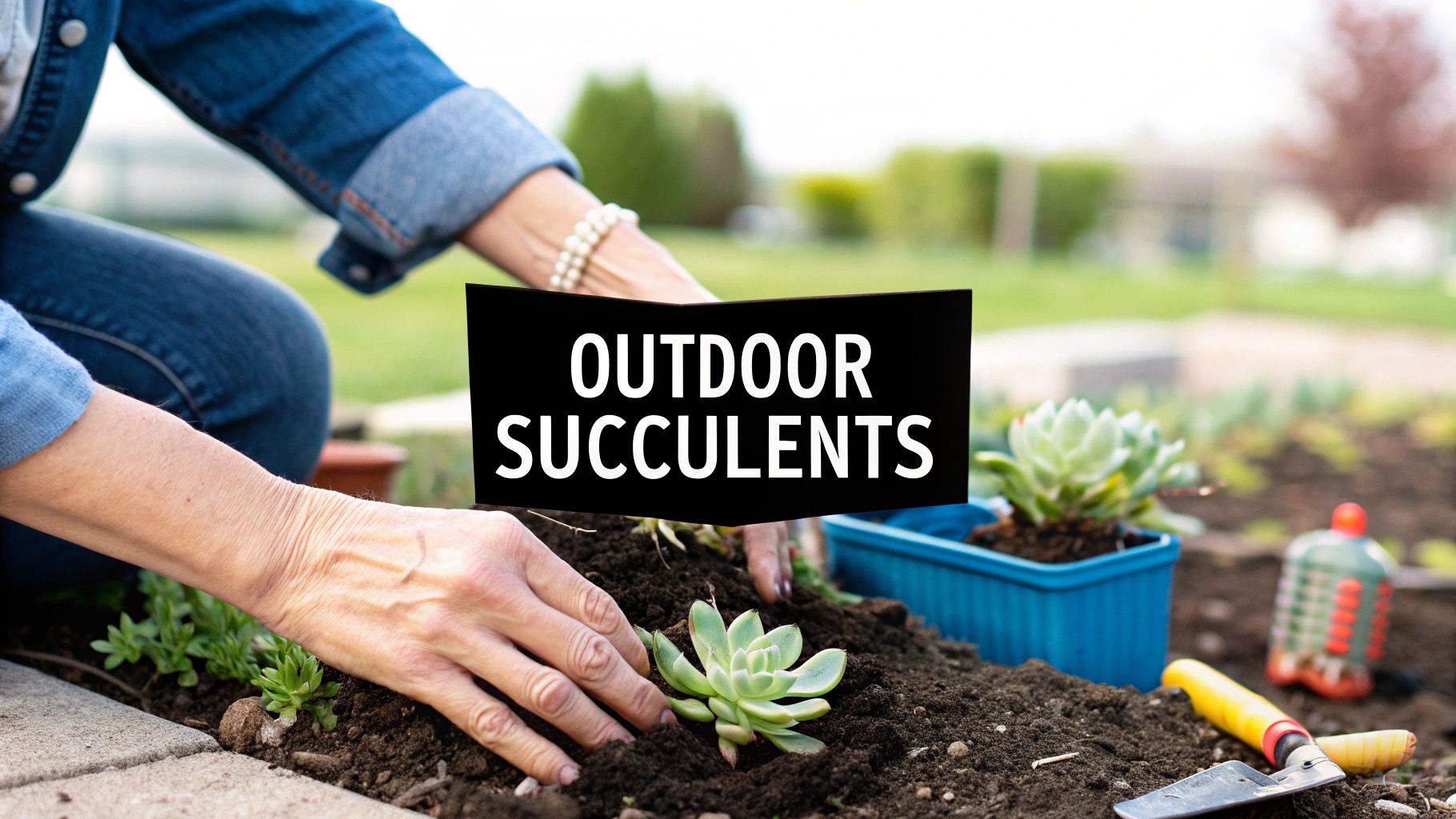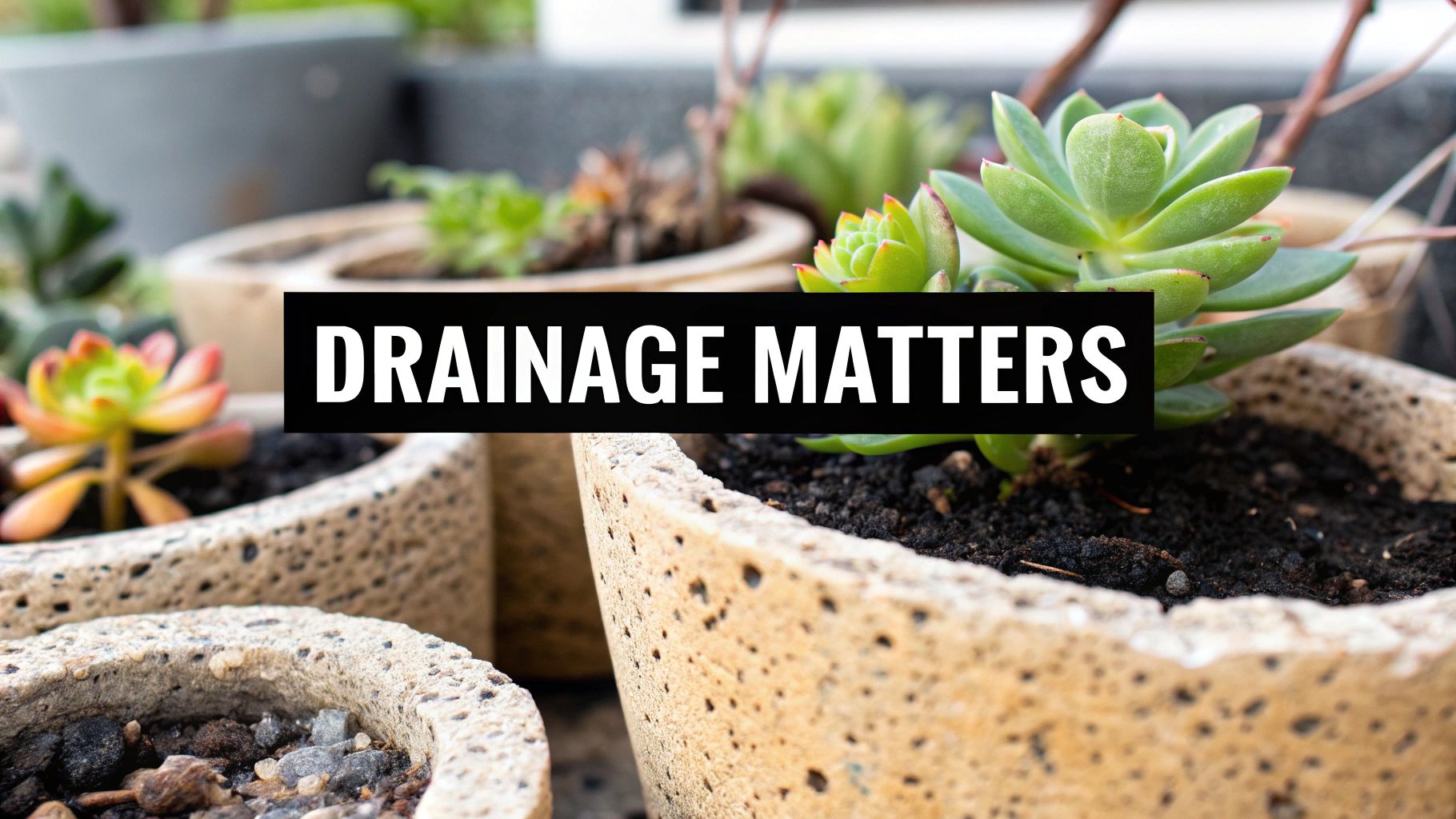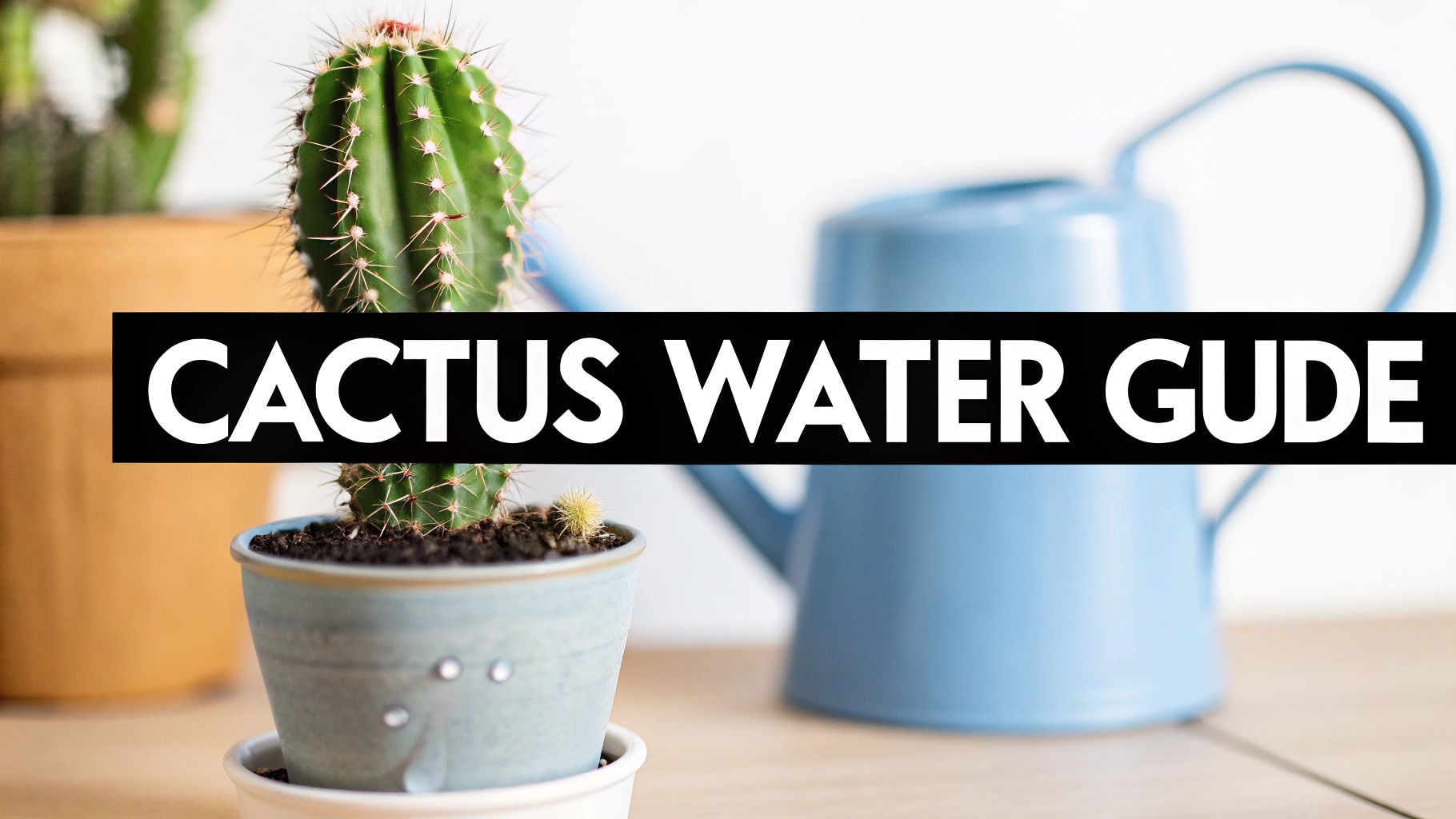The best indoor cactus isn't a one-size-fits-all answer. It really comes down to finding a plant that fits your home's unique environment. For most people, that means something like a Christmas Cactus or Moon Cactus—species that love bright, indirect light and don't mind if you forget to water them now and then. They're a perfect match for the stable, comfortable conditions inside most houses and look great without a ton of fuss.
Choosing Your First Indoor Cactus
Let's bust a common myth right away: not all cacti need to bake in the scorching desert sun. In fact, many of the most beautiful and popular varieties are actually "jungle cacti" or species that naturally grow in the shade of rocks and larger plants. This is great news for us, because it means they're perfectly suited for the kind of bright, filtered light we get in a living room or home office.
Picking the right one is way easier than you might think. It all boils down to just a few key things.
Key Selection Criteria
When you're browsing for your first prickly friend, just keep these three simple elements in mind, and you'll be set up for success:
- Light Requirements: This is the big one. Take a look at the light you actually have. A south-facing window can be pretty intense, while an east-facing one offers gentler morning sun. Most of the best indoor cacti really thrive with the latter.
- Size and Growth Rate: Think about the future. A slow-growing Bishop’s Cap is a fantastic choice for a small shelf because it'll stay compact for years. Other types, however, can quickly outgrow their pots and their designated spot.
- Ease of Care: Be kind to yourself and start with a tough, forgiving species. Cacti known for their resilience will bounce back from the occasional slip-up as you get the hang of their watering and feeding needs. For more tips on giving your plant a bigger home when the time comes, check out our guide on how to repot cacti.
There's no denying the appeal of these sculptural, low-maintenance plants. Their popularity has exploded, with market data showing a steady growth rate of around 15% year-over-year in major markets since 2015. The trend-setters? Old favorites like the Moon Cactus and Christmas Cactus continue to lead the pack.
The biggest mistake I see people make is treating every cactus like it belongs in the desert. The moment you realize that many popular indoor types are actually from tropical or shaded environments, you unlock the secret to helping them not just survive, but truly thrive.
Keep these simple criteria in mind, and you can confidently pick out a cactus that will bring a touch of green and personality to your space for many years to come.
The Secrets to a Thriving Indoor Cactus
Forget everything you know about typical houseplants. A cactus is more like a living sculpture, perfectly designed with its own built-in water tank. Grasping this simple fact is the secret to making them happy. Before we dive into the best types for your home, let’s nail down the ground rules that apply to pretty much any cactus you'll ever own. Get these right, and you can grow anything.
The number one killer of indoor cacti? Too much love, especially from the watering can. These are plants that come from places where rain is a rare, celebrated event. Their roots are simply not built to sit in soggy soil—it's the botanical equivalent of drowning.
Master the Fundamentals of Cactus Care
To sidestep this classic mistake, you have to let the soil become bone dry between waterings. Don't even think about a schedule. Instead, get your hands dirty and poke a finger an inch or two into the soil. If you feel even a hint of moisture, back away and wait. If you really want to get this right, our in-depth guide on watering cactus plants breaks it all down for you.
Just as important is the soil itself. That standard potting mix you have sitting in the garage is a death sentence for a cactus because it’s designed to hold onto water. You absolutely must use a specialized cactus and succulent mix.
A well-draining soil mix is the lifeline for an indoor cactus. It allows water to flow through quickly, giving the roots a drink without forcing them to sit in a puddle. This prevents root rot before it even has a chance to start.
This stuff is gritty and airy by design, usually packed with ingredients like perlite, sand, or pumice. It’s the closest you can get to the dry, rocky ground they're used to, letting water drain fast and giving the roots room to breathe.
Finding the Right Light Balance
Finally, let's talk about sun. We all picture cacti baking in the desert heat, but many of the best indoor varieties actually prefer bright, indirect sunlight. Imagine the kind of light that streams through a sheer curtain—that's the sweet spot.
Here’s a quick rundown on finding the perfect window:
- Ideal Light: An east-facing window is often perfect, offering gentle morning sun that isn’t too harsh. A south-facing window can also be great, as long as the plant is a few feet back from the glass or the light is diffused.
- Too Much Light: Sticking a cactus right against the glass of a hot, south or west-facing window can literally scorch its skin, leaving ugly yellow or brown patches.
- Too Little Light: If you hide your cactus in a dim corner, it will start to stretch and get leggy as it desperately reaches for a light source. This process, called etiolation, leads to weak, pale, and sickly growth.
When you get these three things right—infrequent water, fast-draining soil, and bright, indirect light—you’ve created the perfect environment for your cactus to do more than just survive. It will truly thrive.
Top Indoor Cactus Varieties for Any Home
Alright, now that we've covered the basics of light, water, and soil, we can get to the fun part—actually picking out a plant. Choosing the best cactus for your home is a bit like picking a roommate. You need to find one that fits your space and lifestyle.
Let's dive into some of my top recommendations. These are the cacti that have proven themselves time and again as fantastic indoor companions, from vibrant bloomers to stoic, sculptural types. For each one, I’ll break down what makes it special and give you the essential care tips to help you find your perfect match.
The Ever-Popular Christmas Cactus
The Christmas Cactus (Schlumbergera bridgesii) is a true superstar in the houseplant world, and for good reason. It’s not your typical desert cactus. This one is actually native to the tropical mountains of Brazil, where it happily grows on trees. This little detail about its background is the secret to its indoor success—it prefers to skip the harsh, direct sun and actually enjoys a bit more humidity than its prickly cousins.
Of course, its main claim to fame is the spectacular show of flowers it puts on right around the holidays. The blooms, usually in beautiful shades of pink, red, or white, cascade from the tips of its flat, segmented leaves. It’s like a living piece of holiday decor that brightens up the darkest time of year. If you treat them right, these plants can live for decades, often becoming treasured heirlooms passed down through generations.
Quick Care Guide:
- Light: Give it bright, indirect light. An east-facing window is just about perfect.
- Water: Water it well when the top inch of soil feels dry. Cut back on watering in the fall to help encourage those beautiful blooms.
- Why It's Great Indoors: It loves average household temperatures and humidity and rewards you with a stunning floral display.
The Unmistakable Moon Cactus
Walk into any garden center, and I guarantee you'll spot the Moon Cactus (Gymnocalycium mihanovichii). These quirky, colorful plants are impossible to ignore. What you're seeing is actually two different cacti grafted together: a brightly colored top (often a vibrant red, yellow, or pink) sitting on a sturdy green rootstock.
The funky-colored top is a mutant that lacks chlorophyll, the pigment that lets plants photosynthesize. It literally can't feed itself, so it's grafted onto a green cactus that does all the work. This partnership creates one of the most unique cacti you can bring indoors, especially if you're looking to add a splash of color to a desk or shelf.
The Moon Cactus is a perfect example of botanical teamwork. The vibrant top brings the wow factor, while the green base does the heavy lifting of turning sunlight into energy. This allows a plant that couldn't survive in nature to absolutely thrive in our homes.
Quick Care Guide:
- Light: It needs bright, but filtered, sunlight. Too much direct sun can easily scorch the colorful top.
- Water: Go easy on the water. Only give it a drink when the soil is completely dry. Overwatering is its number one enemy.
- Why It's Great Indoors: Its small size and bold color make it a fantastic little accent plant for tight spaces.
This infographic shows just how important that bright, indirect light is for so many popular indoor cacti, with a sunny windowsill being the ideal spot.
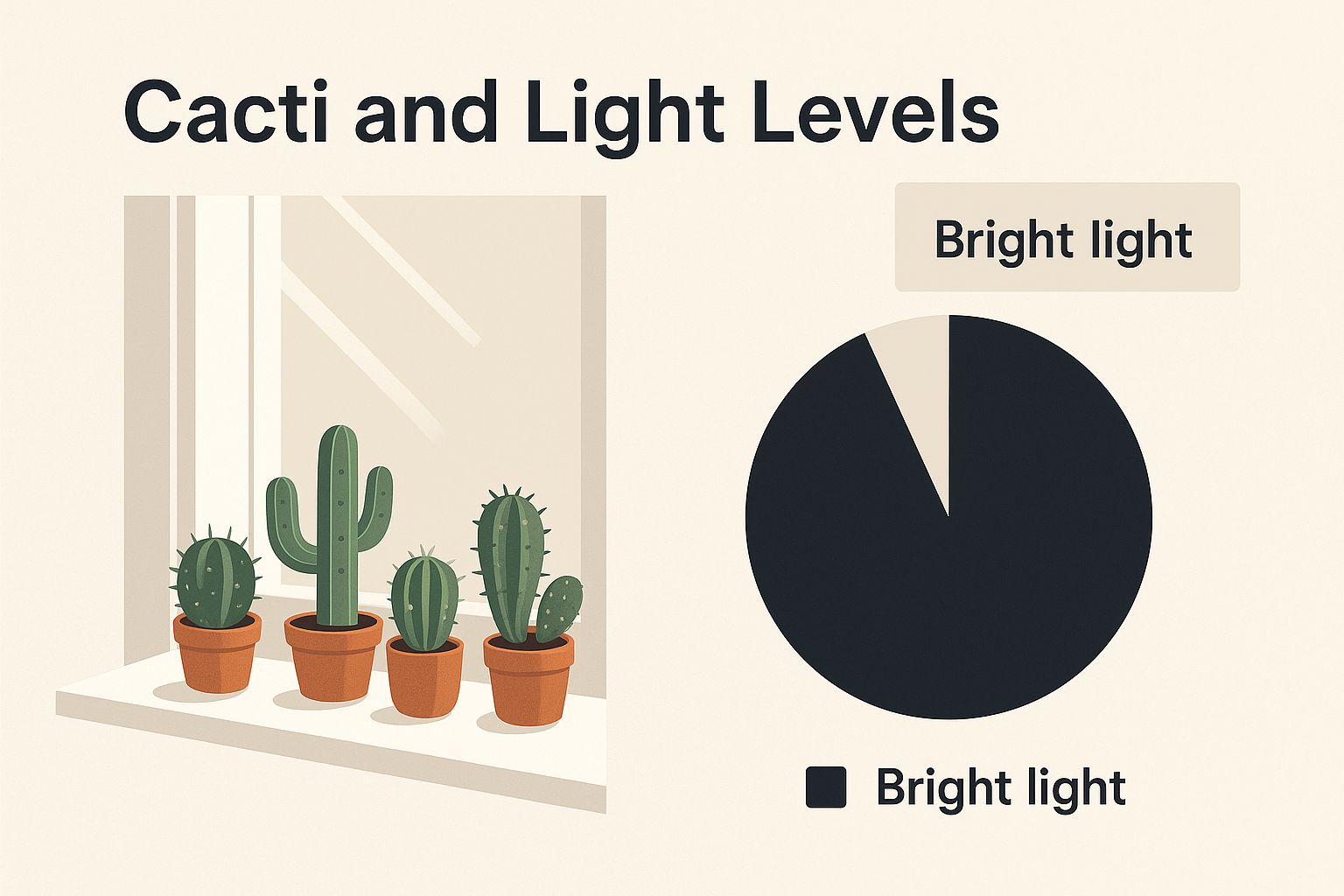
The image really drives home that while these plants are sun-lovers, putting them right up against the glass can be too intense. It's all about finding that balance.
The Classic Barrel Cactus
If you're drawn to that classic, rugged desert look, you can't go wrong with a Barrel Cactus. These stout, ribbed, and heavily spined cacti are the quintessential image of a desert survivor, but they adapt surprisingly well to life indoors. They bring a strong, architectural vibe to any room.
Barrel cacti, especially the Golden Barrel, have become incredibly popular for indoor growing. A big part of the appeal is their incredibly slow growth rate—we're talking less than 1 inch (2.5 cm) per year. This makes them a fantastic long-term investment for your collection because they won't outgrow their spot for a very, very long time. If you want to dive deeper, you can explore more detailed cactus insights on Planet Desert.
Quick Care Guide:
- Light: This one needs a lot of direct sunlight. A south-facing window is its happy place.
- Water: It needs very little water. Let the soil dry out completely between waterings, and don't be afraid to let it stay dry for a bit.
- Why It's Great Indoors: Its slow growth and iconic desert look make it a low-maintenance statement piece with major visual impact.
Quick Comparison of Top Indoor Cacti
To help you see how these popular options stack up, I've put together a simple comparison table. This will give you a quick glance at their needs and features, making it easier to see which one might be the best fit for your home.
| Cactus Name | Light Needs | Watering Frequency | Flowering Potential | Ease of Care |
|---|---|---|---|---|
| Christmas Cactus | Bright, Indirect | Moderate (when top inch is dry) | High (Seasonal Bloomer) | Easy |
| Moon Cactus | Bright, Indirect | Low (when fully dry) | Low | Easy |
| Barrel Cactus | Direct Sun | Very Low (allow soil to stay dry) | Low (rarely indoors) | Very Easy |
As you can see, even among just these three, there's a cactus for almost any light situation and watering style. It really comes down to matching the plant's needs with the environment you can provide.
Finding the Perfect Spot for Your Cactus
So, you've picked out the best cactus for indoors. Now comes the fun part: turning that plant into a piece of your home's decor. Finding the perfect spot isn't just about keeping it alive; it’s about making it a genuine feature that complements your space. This is where plant care and interior design really come together.
Think of your windows as tiny, individual climates. A south-facing window is like a desert oasis, blasting intense light for most of the day—a dream come true for sun-lovers like the Barrel Cactus. On the flip side, an east-facing window offers a much gentler morning sun. This is the sweet spot for cacti that can't handle the harsh afternoon glare, like the Christmas Cactus or Moon Cactus.
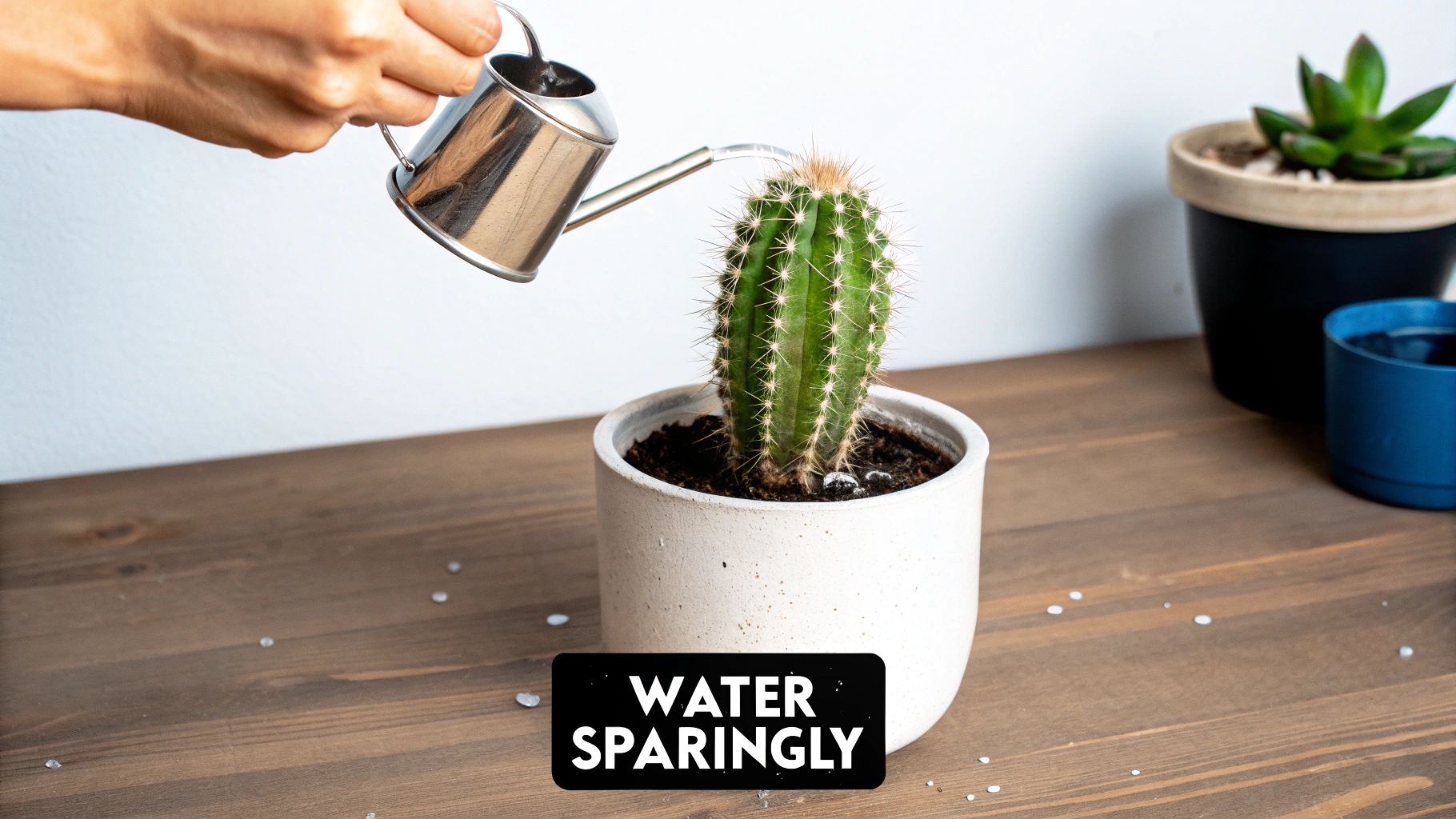
From Plant Placement to Interior Design
But let's be honest, it's not just about the sunlight. Cacti can be powerful design tools. Imagine grouping several smaller cacti with different shapes and textures on a wide windowsill or a bookshelf. You instantly create a miniature desert scene that adds depth and looks like a thoughtfully curated collection.
You can also get strategic with how you manage that light. If a spot is almost perfect but gets a little too intense in the afternoon, things like window treatments for precise light control can make a huge difference, letting you filter the sun as needed.
Don’t forget the pot! The container is half the look.
- For a minimalist or modern vibe, a simple ceramic planter in black, white, or grey looks sharp and clean.
- Going for a bohemian or rustic feel? You can’t go wrong with classic terracotta. It's timeless and great for the roots.
- Want a splash of fun? A brightly colored or patterned pot can transform your cactus into a statement piece all on its own.
Your goal is to create a seamless look where the plant, its pot, and its surroundings all work together. The right spot doesn't just help the cactus thrive—it elevates the entire room.
Finally, a bit of practical advice. A super spiny cactus probably isn't the best choice for a busy hallway, especially if you have kids or curious pets running around. Our guide on where to put a cactus in the house has more room-by-room ideas to help you out. When you put a little thought into it, your cactus stops being just a plant and becomes a living piece of art.
Solving Common Indoor Cactus Problems
Even the most seasoned plant owner runs into trouble now and then, but the good news is that cacti are usually pretty clear about what's wrong. Learning to read the signs is the secret to catching problems before they get out of hand. Think of it less like a crisis and more like being a plant detective—you're just looking for clues to keep your spiny friend thriving.
Most issues boil down to one of three culprits: water, light, or pests. A mushy, brown base is almost always a dead giveaway for overwatering. If the skin turns yellow or looks bleached out, you're likely dealing with a light problem—either too much direct sun or not nearly enough. And if you see tiny webs or little cotton-like specks, you've got visitors. Let's dig into how to spot and solve these common headaches.
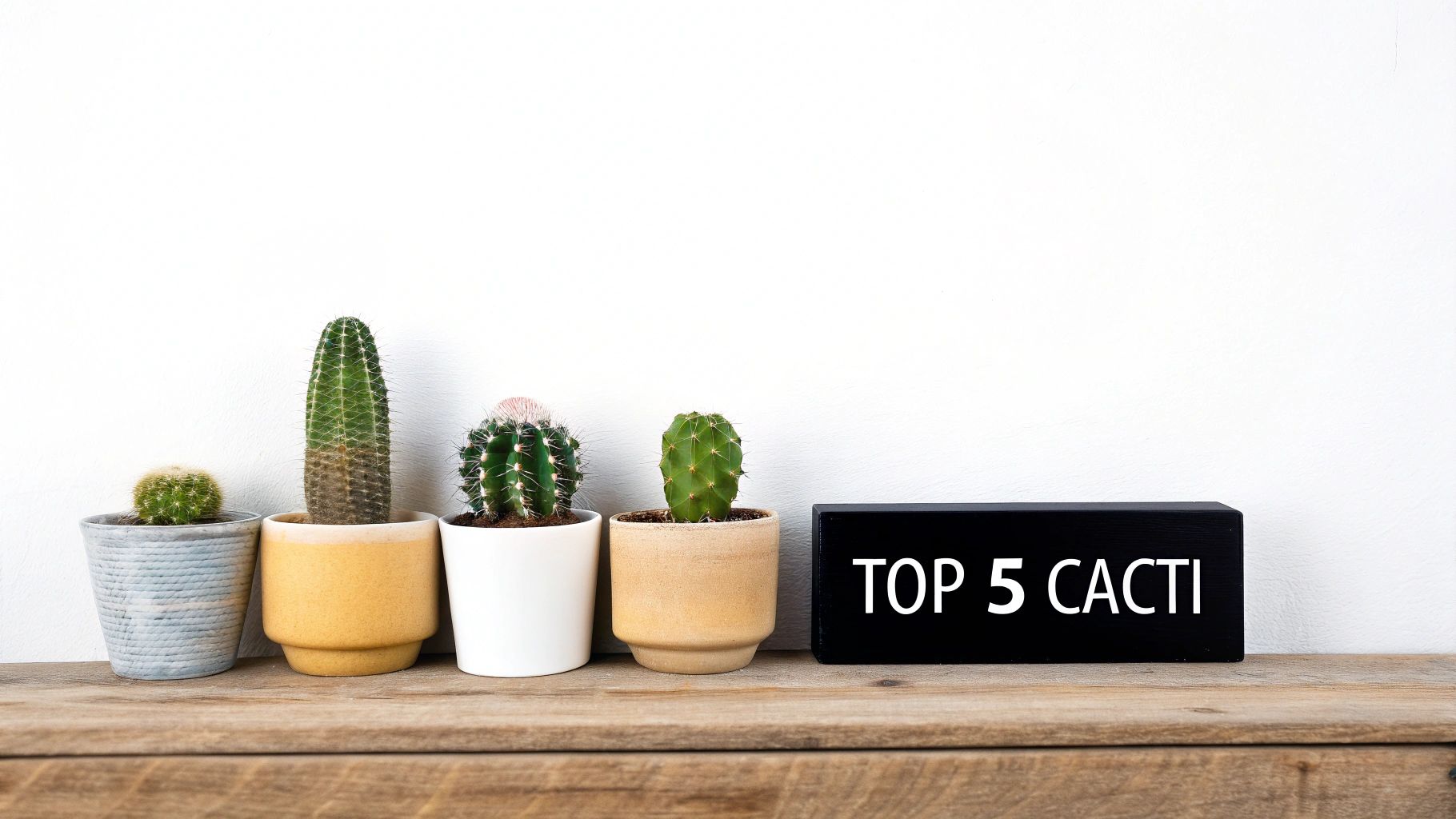
Diagnosing and Fixing Overwatering
This is, without a doubt, the number one mistake people make with indoor cacti. When a cactus is left in soggy soil, its roots can't get any oxygen. This quickly leads to root rot, a nasty condition where the roots literally start to decay. It’s like the plant is drowning, often from too much love.
- The Signs: The base of the cactus gets soft, feels mushy to the touch, and often turns brown or even black. The whole plant might look limp and unhealthy, even though the soil is soaked.
- The Rescue Plan: You have to act fast. Gently slide the cactus out of its pot and clear away the wet soil. Using a clean knife, trim off any roots that are black, slimy, or mushy. If the rot has crept into the cactus body, you’ll need to cut above the rotted part and try to re-root the healthy top section. Let the plant or cutting sit out in the air for a few days to callous over before you even think about repotting it in fresh, dry cactus mix.
Root rot is the fastest and most common killer of indoor cacti. The best defense is simple: when in doubt, don't water. A cactus can bounce back from being thirsty far more easily than it can from being waterlogged.
Correcting Light-Related Issues
Getting the light just right is a balancing act, and your cactus will tell you when you've gotten it wrong.
Problem 1: Etiolation (Stretching)
Is your cactus growing tall, skinny, and pale, almost like it’s reaching for something? That's a classic sign of etiolation. The plant is desperately stretching toward the light source. To fix it, move it to a brighter spot, but do it gradually over a week or two so you don't shock it with a sudden change. That stretched-out growth is permanent, but all the new growth will come in compact and healthy.
Problem 2: Sunburn
On the flip side, if you see ugly yellow or white patches, especially on the side facing the window, your cactus is getting sunburned. It's literally being scorched by intense sun. Just move it a few feet away from the glass or hang a sheer curtain to filter that harsh light. This is why identifying the best cactus for indoors often comes down to honestly assessing the light your windows provide and picking a plant that fits.
Got Questions About Your Indoor Cactus? We've Got Answers.
Even the most seasoned plant parents run into questions now and then. Here are some of the most common things people ask about their indoor cacti, along with some straightforward answers to keep your prickly friends happy.
How Often Should I Water My Indoor Cactus?
Forget about watering on a strict schedule. The single most important rule for watering cacti is to check the soil first. Your cactus only needs a drink when its soil has completely dried out.
The best way to check is to stick your finger about an inch into the pot. If it comes out clean and dry, it's watering time. If you feel any moisture at all, wait a few more days and check again. In the winter, your cactus will be dormant and needs even less water—maybe just once a month.
Do Cacti Really Need Special Soil?
Absolutely. This is one area where you can't cut corners. Regular potting soil is a cactus killer because it’s designed to hold onto water, which leads to soggy roots and, inevitably, rot.
You'll need a special cactus or succulent mix. These blends are gritty and fast-draining, usually containing sand, perlite, or pumice. This mimics the arid, rocky soil of their native habitats and is crucial for keeping their roots healthy.
Why Is My Cactus Getting All Skinny and Stretched?
If your cactus looks like it's stretching out and getting thin, that's a classic sign it isn't getting enough sun. This condition is called etiolation, and it's your plant’s desperate attempt to reach for more light.
To fix it, you need to slowly introduce it to a brighter spot (don't just move it into direct sun, or it could scorch!). The stretched-out part won't go back to normal, but any new growth will be much healthier and more compact.
Ready to find the perfect prickly companion for your home? Explore our extensive collection at The Cactus Outlet and discover a wide variety of beautiful, healthy cacti delivered right to your door. Start your collection today at https://www.cactusoutlet.com.


